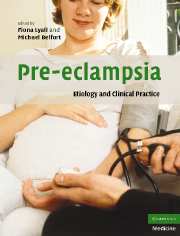Book contents
- Frontmatter
- Contents
- List of contributors
- Preface
- Part I Basic science
- 1 Trophoblast invasion in pre-eclampsia and other pregnancy disorders
- 2 Development of the utero-placental circulation: purported mechanisms for cytotrophoblast invasion in normal pregnancy and pre-eclampsia
- 3 In vitro models for studying pre-eclampsia
- 4 Endothelial factors
- 5 The renin–angiotensin system in pre-eclampsia
- 6 Immunological factors and placentation: implications for pre-eclampsia
- 7 Immunological factors and placentation: implications for pre-eclampsia
- 8 The role of oxidative stress in pre-eclampsia
- 9 Placental hypoxia, hyperoxia and ischemia–reperfusion injury in pre-eclampsia
- 10 Tenney–Parker changes and apoptotic versus necrotic shedding of trophoblast in normal pregnancy and pre-eclampsia
- 11 Dyslipidemia and pre-eclampsia
- 12 Pre-eclampsia a two-stage disorder: what is the linkage? Are there directed fetal/placental signals?
- 13 High altitude and pre-eclampsia
- 14 The use of mouse models to explore fetal–maternal interactions underlying pre-eclampsia
- 15 Prediction of pre-eclampsia
- 16 Long-term implications of pre-eclampsia for maternal health
- Part II Clinical Practice
- Subject index
- References
7 - Immunological factors and placentation: implications for pre-eclampsia
from Part I - Basic science
Published online by Cambridge University Press: 03 September 2009
- Frontmatter
- Contents
- List of contributors
- Preface
- Part I Basic science
- 1 Trophoblast invasion in pre-eclampsia and other pregnancy disorders
- 2 Development of the utero-placental circulation: purported mechanisms for cytotrophoblast invasion in normal pregnancy and pre-eclampsia
- 3 In vitro models for studying pre-eclampsia
- 4 Endothelial factors
- 5 The renin–angiotensin system in pre-eclampsia
- 6 Immunological factors and placentation: implications for pre-eclampsia
- 7 Immunological factors and placentation: implications for pre-eclampsia
- 8 The role of oxidative stress in pre-eclampsia
- 9 Placental hypoxia, hyperoxia and ischemia–reperfusion injury in pre-eclampsia
- 10 Tenney–Parker changes and apoptotic versus necrotic shedding of trophoblast in normal pregnancy and pre-eclampsia
- 11 Dyslipidemia and pre-eclampsia
- 12 Pre-eclampsia a two-stage disorder: what is the linkage? Are there directed fetal/placental signals?
- 13 High altitude and pre-eclampsia
- 14 The use of mouse models to explore fetal–maternal interactions underlying pre-eclampsia
- 15 Prediction of pre-eclampsia
- 16 Long-term implications of pre-eclampsia for maternal health
- Part II Clinical Practice
- Subject index
- References
Summary
In this chapter what constitutes a systemic inflammatory response is described. Evidence is presented that normal pregnancy evokes such a response and that pre-eclampsia arises when the response becomes extreme and decompensates. The possible causes of systemic inflammation in pregnancy are reviewed, as is the relation between the inflammatory response and systemic oxidative stress. The interaction between systemic inflammation and changes in lipid and glucose metabolism are described and the relevance of long-term systemic inflammation as a predisposing risk factor is outlined. It is suggested that the metabolic results of systemic inflammation may endow a survival advantage for the fetus. Last, the systemic inflammation is related to other immune responses that are thought to be important for the success or failure of pregnancy.
Immune and inflammatory responses
In evolutionary terms, inflammatory responses are older than immune responses. The latter are superimposed on the former and cannot work without it. The primitive innate (inflammatory) system responds quickly and is relatively non-specific. The more sophisticated adaptive immune system is slow but precise, delivering antigen-specific responses with astonishing versatility and accuracy. The innate and adaptive systems are asymmetrically interdependent. The innate system does not need the adaptive system to function, whereas the adaptive system cannot function without signals from the innate system, nor need it provoke antibodies of antigen-specific cytotoxicity. This is a crucial consideration in relation to this chapter. A systemic inflammatory response is not necessarily generated by antigenic stimulation.
- Type
- Chapter
- Information
- Pre-eclampsiaEtiology and Clinical Practice, pp. 103 - 120Publisher: Cambridge University PressPrint publication year: 2007



